Figure 4. The Notch receptor is differentially localized in worker ovaries.
Activation of the Notch receptor causes part of the receptor to become cleaved (NICD) where it moves to the nucleus to regulate gene expression. (a) Immunohistochemistry using an antibody against the NICD indicates that in queen-right worker bees the NICD is predominately nuclear-localized in the cells of the terminal filament and all of the cells of the germarium. The NICD is also present in the nucleus of the anterior terminal filament cells in queen-less worker bees; but the NICD is essentially absent from the anterior germarium. In the posterior germarium, as oocytes become clearly identifiable, the NICD is detectable on cell membranes but not in the nuclei. In queen ovarioles, the NICD is present in the nucleus of cells of the terminal filament, indicating that these cells are receiving a Notch signal, but there is little immunoreactivity detected throughout the germarium. Ovaries were counter-stained with DAPI and phalloidin to visualize nuclei and cortical actin. (b) We examined the expression of Numb, a gene implicated in regulation and recycling of the Notch receptor, using qRT–PCR and in situ hybridization. qRT–PCR indicates that numb mRNA is induced more than twofold when the queen is removed from the hive before any morphological difference is detectable in the ovaries. qRT–PCR data is the mean of transcript levels (Log10) in five biological samples for each condition. Boxplot whiskers indicate minimum and maximum, the box is defined by 25th percentile, median and 75th percentile. Differences in target gene expression were determined by analysis of variance with a Tukey's LSD post hoc test, statistical differences (P<0.05) are denoted by different letters. (c) Numb mRNA is barely detectable in the germarium of queen-right worker bees, but is readily detectable in the germarium of queen-less and queen ovarioles. Following in situ hybridization ovaries were counter-stained with DAPI (right panels). Scale bars, 100 μm. Arrow heads indicate the border between cells of the terminal filament and germarium. (d) Proposed model summarizing the role of QMP in regulating oogenesis via Notch signalling in the honeybee-worker ovary.

